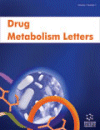- Home
- A-Z Publications
- Drug Metabolism Letters
- Previous Issues
- Volume 14, Issue 2, 2021
Drug Metabolism Letters - Volume 14, Issue 2, 2021
Volume 14, Issue 2, 2021
-
-
The Link Between Conventional and Novel Anti-Cancer Therapeutics with Thrombotic Microangiopathy
More LessAuthors: Carmen E. Cervantes, Sam Kant and Mohamed G. AttaBackground: Kidney disease associated with cancer and anti-cancer therapies has been increasingly recognized in the field of onco-nephrology. In particular, drug-induced nephrotoxicity has important implications since most chemotherapeutic agents have a nephrotoxic potential. Also, standard creatinine clearance methods used for the measurement of kidney function have been questioned in cancer patients due to fa Read More
-
-
-
Management of Acute Aluminum Phosphide Poisoning: Has Anything Changed?
More LessAuthors: Lokhesh C. Anbalagan, Navneet Arora and Ashok K. PannuDue to its easy availability, rapid and severe toxicity, and no specific antidote, aluminum phosphide has emerged as a lethal toxin, commonly used for suicidal intent in agricultural communities. Despite various advances in medicine, this compound’s toxicity is poorly understood, and it still has a very high case fatality rate with no definitive treatment options available. This review aims to understand the mechanism of toxicity, clini Read More
-
-
-
Biological Importance, Therapeutic Benefit and Analytical Aspects of Bioactive Flavonoid Pectolinarin in the Nature
More LessBackgrounds: Plants and their derived products have been used in the traditional system of medicine for the treatment of various forms of human disorders since very ancient times. In the traditional system of medicine and modern allopathic medicine, numerous phytoconstituents have been used for the preparation of various types of formulation. Flavonoidal class phytochemicals are the main active phytoconstituents of plan Read More
-
-
-
The Role of Aldehyde Oxidase in the Metabolic Clearance of Substituted Benzothiazoles
More LessAuthors: Yohannes Teffera, Jingzhou Liu, Paul Krolikowski and Zhiyang ZhaoBackground: A group of substituted benzothiazoles from a research project was found to have low microsomal clearance. However, these compounds had very high clearance in vivo. Methods: In the present study, the clearance mechanism of two of the structural analogs, was investigated in vitro and in vivo. Results: In vitro studies showed the formation of corresponding non-P450 dependent oxidative metabolit Read More
-
-
-
Pharmacokinetics Parameters of Diagoxin among Saudi Patients in Qassim Region, Saudi Arabia
More LessAuthors: Abdulaziz S. Allihimy, Ahmad A. Almeman, Nassar A. Alnassar and Jihad AlmadhiBackground: The pharmacodynamic effects of digoxin are susceptible to multiple factors, most notably, heart uptake of the digoxin dose and its concentration in the serum. Another important factor to mention is the renal function state of an individual. Objective: In this study, we aimed to develop a simple algorithm based on subsets of clinically relevant information, which will help to personalize digoxin based on pharmaco Read More
-
-
-
Assessment of Prescribability and Switchability by Using Multiple Bioequivalence Assessment Approaches
More LessAuthors: Francis Micheal, Mohanlal Sayana, Rajendra Prasad and Balamurali M. MotialBackground: In the drug development process, an assessment of bioequivalence is an integral part. For the evaluation of generics against the comparator, average bioequivalence approach is the gold standard method. In the recent past, there were many discussions on whether we have the adequate tool to evaluate generics and thereby drug interchangeability (prescribability and switchability) issue is addressed as avera Read More
-
-
-
An Effective QWBA/UHPLC-MS/Tissue Punch Approach: Solving a Pharmacokinetic Issue via Quantitative Met-ID
More LessAuthors: József Pánczél, Manfred Schudok, Matthias Schiell, Jens Riedel and Vilmos KerteszBackground: Methods to provide absolute quantitation of the administered drug and corresponding metabolites in tissue in a spatially resolved manner is a challenging but much needed capability in pharmaceutical research. Quantitative Whole-Body Autoradiography (QWBA) after a single- dose intravenous (3 mg/kg) and extravascular (30 mg/kg) administrations of an in vitro metabolically stable test compound (structure no Read More
-
Most Read This Month
Article
content/journals/dml
Journal
10
5
false
en


